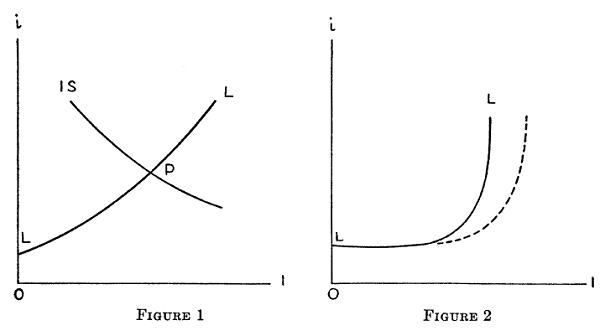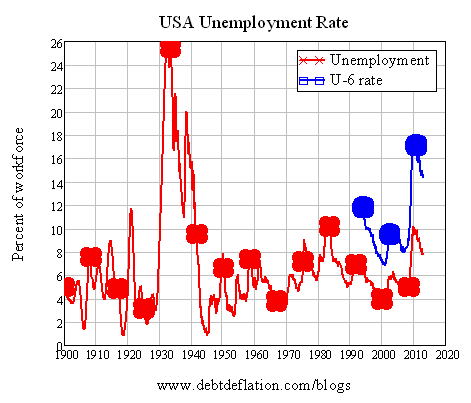Krugman: IS-LM economic modeling failure (part 1)
By Steve Keen
Editor’s note: This is a post in at least 4 parts. Part 1 is below
Paul Krugman describes himself as a “sorta-kinda New Keynesian”, and explains in his book End This Depression NOW! that New Keynesian macroeconomics evolved in reaction to the failure of the new classical approach to “explain the basic facts of recessions”.
His “sorta-kinda” qualification is because both New Keynesian and new classical models derived from applying assumptions about the behaviour of individuals and markets at the level of the macroeconomy, and he has a healthy scepticism about these assumptions:
“I don’t really buy the assumptions about rationality and markets that are embedded in many modern theoretical models, my own included, and I often turn to Old Keynesian ideas, but I see the usefulness of such models as a way to think through some issues carefully – an attitude that is actually widely shared on the saltwater side of the great divide.”
This is one aspect of Krugman that I genuinely applaud: the awareness that models aren’t reality. At best they are representations of reality, but some neoclassicals show an amazing capacity to believe that their models are reality – as in this piece by French economist Gilles Saint-Paul which the blog Unlearning Economics deservedly flogged recently – in a way that leads to truly delusional thinking about the real world.
Of course, we need models to think about the economy in the first instance, because it is such a complex entity. Even those who deride modelling in economics are using a model when they talk about the economy – it’s just a verbal (or even unarticulated) one, as opposed to an academic construct.
One might hope that experience and experimentation over time would weed out unrealistic models in economics, but that hasn’t happened. In many ways, the models that dominate economics today are less realistic than those which prevailed as much as seventy years ago.
Krugman alludes to this by his reference to “Old Keynesian ideas” above. In particular, he champions John Hicks’ IS-LM model as an explanation of our economic crisis today.
This model, first published in 1937, seeks to explain the relationship between interest rates on one hand and real output, in goods and services and money markets, on the other.
In his first paper on the model, Hicks proposed that the Great Depression was caused by what was later termed a “liquidity trap”. Hicks argued that it was possible for the economy to be in an equilibrium (a word I’ll be labouring in this post) in which there was involuntary unemployment.
(Why the word “involuntary”? Because the so-called ‘freshwater’, new classical economists that Krugman is accustomed to fighting argue that all unemployment is voluntary: people look at the current wage, consider the loss of leisure they’d incur to have to work for it, and decide that not working gives them higher utility.)
To get down to the technical nuts and bolts, Hicks’ model had two intersecting curves. They were called the IS curve (representing Investment – Saving) and the LL curve (representing Luiquidity Preference –Money Supply; this was later relabelled LM). These were drawn on a diagram with the rate of interest (i) on the vertical axis and the level of income (I) on the horizontal. (Income was later labelled “Y” to get away from the sheer bloody confusion of multiple “I”s). And the point where the two lines intersected represented equilibrium in both markets.
I’ll delay explaining how the curves are derived until I get to Krugman’s use of the model; for now the important thing is the shape of the curves.
Figure 1: Hicks’ original IS-LL model, from page 153 of his 1937 paper Mr Keynes & the Classics
Hicks argued that the LM curve would be flat at low levels of the rate of interest, and steep at high levels of income (as shown in his figure 2). This was because, as he put it, “there is (1) some minimum below which the rate of interest is unlikely to go; and (though Mr Keynes does not stress this) there is (2) a maximum to the level of income which can possibly be financed with a given amount of money.”
Hicks then used this to divide the diagram into two regions, depending on where the IS curve intersected the LM.
If the intersection was in the section where LM was rising steeply, then an increase in demand – caused by, for example, a budget deficit – would mainly drive up the rate of interest, with very little impact on the level of income. This was the ‘classical’ region where what is today called ‘crowding out‘ (when government borrowing reduces investment spending by crowding out private investment)would occur and where deficits only cause bad things like higher interest rates (and, in more elaborate models, inflation).
However if the IS curve intersected with LM in its flat region, then an increase in demand via a government deficit would drive the equilibrium income level higher, while having very little impact on the rate of interest. This was the region where Keynes’s arguments applied, said Hicks: that when the economy was depressed and income was very low, the government should stimulate demand by expansionary policy.
It was also where monetary policy was ineffective – as Hicks illustrated in his figure 2. Because there was already a minimum level for the rate of interest – which later economists christened “the zero lower bound” – then this bit of the curve couldn’t be shifted by increasing the amount of money. Only if the economy were in the ‘classical’ region, would increasing the supply of money move the LM curve further out – as shown by the dotted line in Hicks’ figure 2. Therefore monetary policy was effective when income was high, but ineffective when income was low (and unemployment was high).
On the other hand, in the region where the LM curve was flat, monetary policy was ineffective but fiscal policy – which could shift the IS curve – worked. Since this was what Keynes was advocating in The General Theory, Hicks concluded: “So the General Theory of Employment is the Economics of Depression”.
The IS-LM model took over the academic profession in part because it eliminated the apparent existential threat to neoclassical economics that appeared to exist elsewhere in Keynes’s work – as for example in these wonderfully confrontational lines from Keynes’s own summary of his message in the paper The General Theory of Employmentin 1937. “I accuse the classical economic theory of being itself one of these pretty, polite techniques which tries to deal with the present by abstracting from the fact that we know very little about the future,” Keynes said.
Instead, there could be peaceful co-existence: neoclassicals owned the boom times, while Keynesians got the bad times. But just as with peaceful coexistence in the geopolitical sphere, at least one side didn’t really believe in it. Neoclassicals hoped for total domination, and in the battle to achieve it they were aided both by economic circumstances and by the nature of that other sphere of economics, microeconomics.
After WWII, the times appeared to be good all the time – certainly in comparison to The Great Depression, when unemployment hit 26 per cent (see figure 2) – so that neoclassicals got most of the airplay and Keynesians very little. Neoclassical theory also ruled the microeconomic roost, and from this fortress emerged a campaign to destroy Keynesian thought entirely.
Figure 2: US Unemployment rate. The U-6 measure today is comparable to the official measure in the 1930s

In what became known as the microfoundations debate, neoclassicals attacked the Keynesian part of the profession with the charge that Keynes “did not have good microfoundations” – that Keynesian results like an equilibrium with unemployment contradicted microeconomic theory. As Lucas emphasised in his 2003 speech to the History of Political Economy conference when he was President of the American Economic Association, a key target in this assault was Hicks’ IS-LM model. “Nobody was satisfied with IS-LM as the end of macroeconomic theorising,” he said. “The idea was we were going to tie it together with microeconomics and that was the job of our generation.”
Now the bad times are back, and Krugman is trying resuscitate IS-LM. I argue that he should leave it dead – not for the reasons that the new classicals killed it off (being inconsistent with neoclassical microeconomics is a plus in my books) but because it’s a lousy model for what we’re experiencing right now. There’s no better way to show this than to outline how Krugman is trying to use it, and show that he gets it wrong. I’ll do that tomorrow morning.
Editor’s note: Steve has invented an innovative way to build models of the economy that actually include banks and debt. He has started a campaign to support that model called “Kickstarter”. The goal is to pay programmers to develop software for the model called Minsky, after famed economist Hyman Minsky. There are only nine days left to help kickstart Minsky and help Steve reach his stretch goals:
$100,000: About 1400 hours of total programming time will enable Russell to complete the “Mun” release, which will focus on improving the graphics and presentation aspects of the program.
Nathan will also be able to develop a version of Minsky for iPad and Android Tablets.
$250,000: With twice as much as the original INET Grant, we should be able to complete stage 2 of Minsky—the “Quesnay” release named in honor of the person I regard as the world’s first dynamic economist, Francois Quesnay—in which the platform could support the construction of multi-bank model of the financial sector, and a multi-commodity model of production.
Comments are closed.